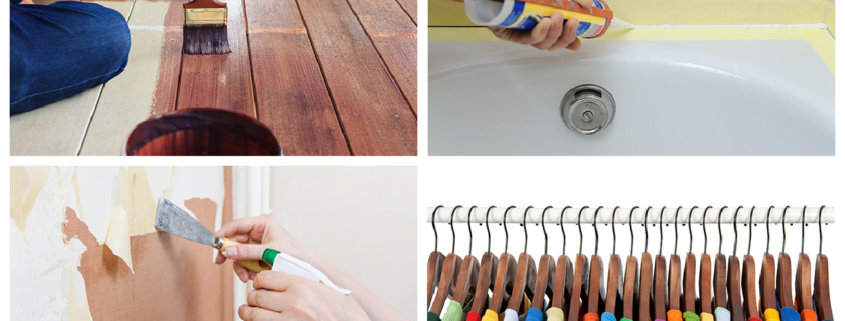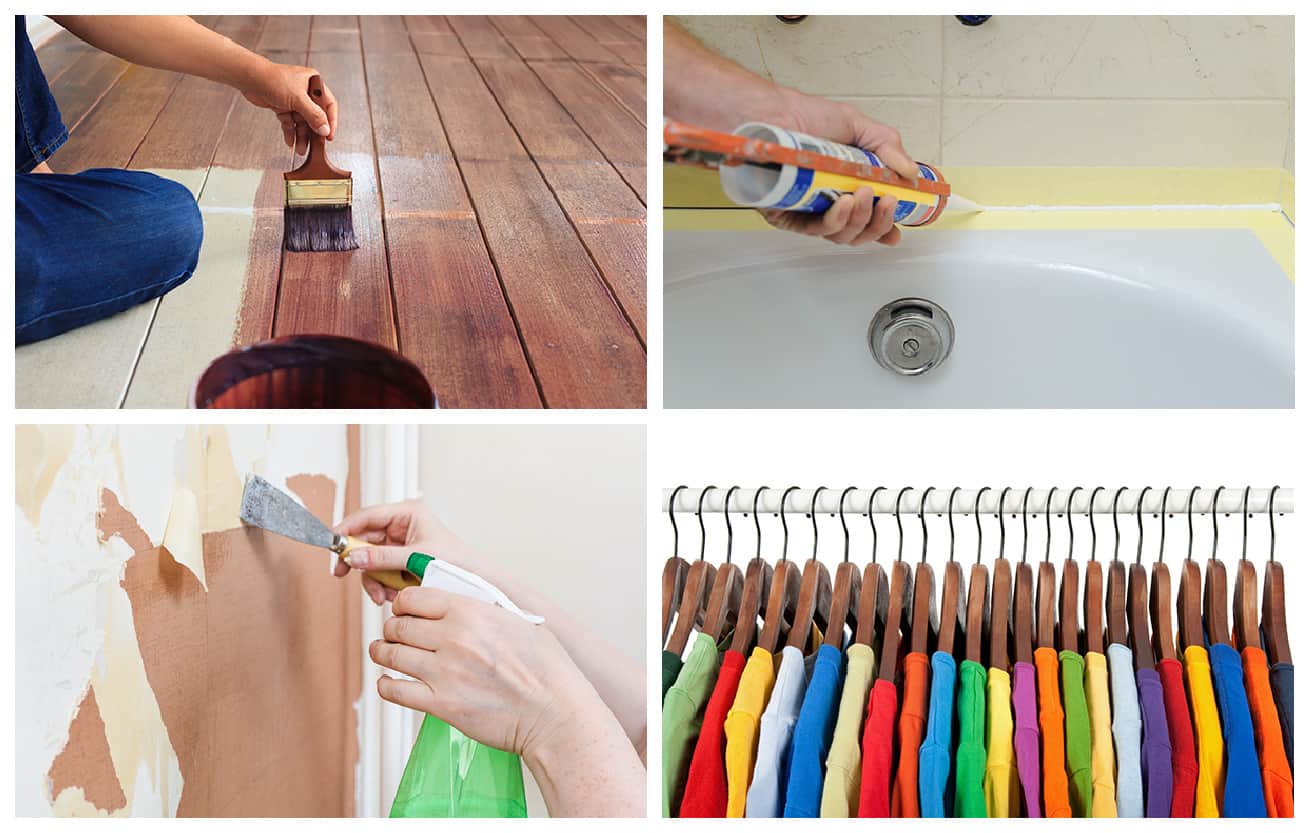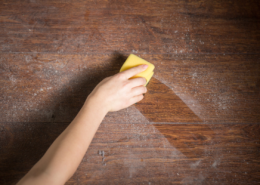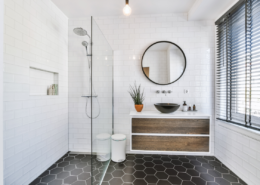Practical Tips to Help with Home Maintenance and Repair
Maintenance costs can put a serious dent in your budget and savings—a dent that’s tough to repair. And while there are certain things you need an expert to handle, there are plenty of other situations in which you can make minor but meaningful repairs without needing professional support—while saving serious cash.
From closet rods to floor repair, and from wallpaper tricks to paint smarts, here is a simple sampling of practical tips and brilliant ideas to help around the house.
Closet Rod Fix
To fix a sagging clothes closet rod, buy a length of 1/2-inch galvanized pipe and a length of 3/4″ thin-wall PVC (plastic, polyvinyl chloride) piping, both the same length as the rod. You can get these at your local home improvement centers such as Home Depot or Lowes. Remove the existing sagging rod. Now slip the pipe inside the PVC to create a new rod and slide this into the existing rod brackets. If you are bothered by the printing on the PVC, clean it off with rubbing alcohol.
Goofs are Good
Want to paint your basement floor but not spend the $200 or more the paint store quoted? Instead, ask for their oil-based goofs (paint tinted the wrong color), which work well on unsealed cement. You can usually collect five gallons for much less than the shelf price since the store is anxious to get rid of those mistakes! Of course, it might turn out a strange shade of gray due to mixing odd colors. But hey, it’s a basement floor!
Pot Repair
Don’t throw out that bused terra-cotta pot. You can repair it quite easily. Moisten the breaks with water. Squeeze carpenter’s glue onto the broken edges and reset the pieces. Circle the pot with strips of masking tape to hold the pieces in place. et the bond harden. Elmer’s Glue-All is a good choice here, as once dry, it’s waterproof and bonds stronger than the wood.
Paint Storage
Don’t let those leftover portions of paint go to waste. Store partially full cans of paint upside down. The paint will form an airtight seal, extending the useful life.
Easy to Go Darker
When you are staining your wooden floor, the thing you should bear in mind is that you can always go darker in staining, but you cannot go lighter. To go darker in terms of stain, you need only apply more coats of the stain until you are comfortable with the tint of your stain.
Hide Furniture Scratches
Here’s a great way to hide scratches on wood furniture: First soak the scratch with a bit of water to open the wood grain. Select a crayon that is as close to the right color as possible. Apply the waxy substance to the scratch; rut it in well with a soft cloth and then buff.
Fill nail holes
While you have those crayons out, take a moment to fill all the unsightly nail holes in the walls. Pick the closest color then fill it using the crayon. It will appear to, well, disappear!
Detect a leak
Check to make sure your toilet is not leaking, which would be sending your water utility bill through the roof. Do this: Lift the cover off the toilet’s tank in the back of the toilet (where the flushing mechanism resides) and drop a few drops of food coloring into the tank’s water. Replace the tank cover. Now lift the toilet seat and look into the bowl. Do you see any of that food coloring. If so, you have a leak that needs to be fixed.
Neat Caulk
If you have trouble getting the caulking around the tub or sink to look right, use this trick: Tape the tub with painter’s tape leaving about 1/4 to 1/2 inch on either side of the joint for the caulking. Now squeeze the new caulk and smooth it out. Remove the tape and you have a neat and clean line, and the caulk looks great. Make sure to remove the tape before the caulk starts to set carefully.
Wallpaper Remover
Plain white vinegar makes a great wallpaper remover. First, remove all of the wallpaper you can by simply pulling it off. You’l probably get only the top layer of the paper, and that’s okay. Now, spray full-strength vinegar on what remains. This will begin to dissolve the glue. Once softened you’ll be able to remove the rest without harsh chemicals.
Freezer Paintbrush
When tackling a painting job you may not be able to complete in one day, don’t waste all of the paint in the rollers and brushes by cleaning them. Simply wrap them tightly in plastic wrap and store them in the freezer The next day, remove the wrap, and you’ll be ready to pick up right where you left off.
Perfect Pilot
To prevent wood from splitting, professional woodworkers drill a “pilot hole” before nailing molding or floor base in place. If you can’t find a bit small enough to match the nails you’re using, cut off the head of one of the nails with a pair of nippers. Then place it in the chuck of your power drill just as you would a regular drill bit. The nail easily cuts through the molding and makes the correct size hole for the finishing nail.
Paint Post-Op
Most counties have Hazardous Household Materials programs and collection sites where residents can drop off items that should to end up in landfills. They get all types of paint, ranging from latex, oil-based, primer, interior, exterior, and stain. sometimes the paint dropped off at the site is brand new. Many sites have policies that allow you to take what you can use, provided you sign a waiver stating that you will use it appropriately. It’s worth checking out
Gasket Maintenance
The rubber door gasket is one of the first things to wear out on a refrigerator. You can perform simple preventive maintenance by applying a very thin coat of petroleum jelly (Vaseline) to the gasket to protect it from mildew, drying, and cracking.
Air Conditioner Filter
To clean an air conditioner or humidifier filter, remove the foam filter from the grill and soak it in a solution of equal parts white vinegar and warm water. If you clean the filter regularly, an hour of soaking will be plenty. Just squeeze the filter dry when it’s clean, and place it back in the air conditioner.
Aluminum Like New
Make aluminum doors or window casings look new by rubbing a ball of aluminum foil back and forth across the pitting.
Citronella in the Paint
A few drops of citronella oil added to a bucket of paint will keep mosquitoes and other flying insects away from a fresh paint job.
Drill for Water
If you notice water leaking through the ceiling, immediately hammer a 16d (3-inches long) nail through the sheetrock to allow the water to drain before it damages the plaster or drywall. Later, after the leak is repaired, all you’ll need to cover the emergency repair is a dab of Spackle and touch-up paint.
Fix Leaky Faucets
A faucet leaking 60 drops a minute wastes 113 gallons of water a month. That’s 1,356 gallons a year down the drain.
Keyholes That Glow in the Dark
Brush keyholes with luminous paint, and you won’t fumble for the lock in the dark.
Hinges that Squeak
Lubricate the pin on a squeaky hinge with petroleum jelly (Vaseline) instead of oil. You won’t need to worry about drips on the floor.
Identify Clear Finish
To identify the type of clear finish on wood so you can refinish it, touch the finish with a cotton ball dampened with nail polish remover. If the cotton ball sticks or the finish softens, it’s varnish, lacquer, or shellac. If there’s no effect, it’s polyurethane.















Thank you for sharing all these tips! I have one more thing to share.
If you have a clogged drain, try to remove the blockage by pouring a pot of boiling water down the drain. Next, pour a cup of baking soda and 1 cup of water/1 cup of vinegar solution. Cover with the drain plug and wait for 5 to 10 minutes. Then pour boiling water down the drain again.
I’m not sure what type of caulk it was in the tub surround, but I was able to remove it fairly easily with Goo Gone Caulk Remover.
About removing wallpaper….could I have more details? How long does the vinegar sit to work? And then do I need to buy a wallpaper scorer or just use a putty scraper? This stuff was put up in the 80s and it will be quite a job, so I need all the help I can get at my age! Thanks.
One of the best ideas I’ve ever seen on the internet is for paint storage.
Paint storage and use is very easy. Use a clean empty plastic bottle of detergent (such as Tide).
Pour the paint into the bottle and store. It has a built in spout. You can shake the paint up in the bottle and pour it out without spilling. If you just need a little bit, pour some paint into the cap and use it. When you’re finished, just put the cap back on the bottle. No mess, no fuss!!
Love that, Beth. Thanks for sharing!
Bathroom caulk drives me nuts. I can get it to go on neatly. But all caulk eventually needs to be replaced, and that’s when I have problems. Our old caulk was stained, and no mount of cleaning or type of cleaning products has helped. I need to remove it, but it’s proving to be stubborn. Is there a way to do this without damaging the composite shower pan? It’s silicon caulk.
Try WD40